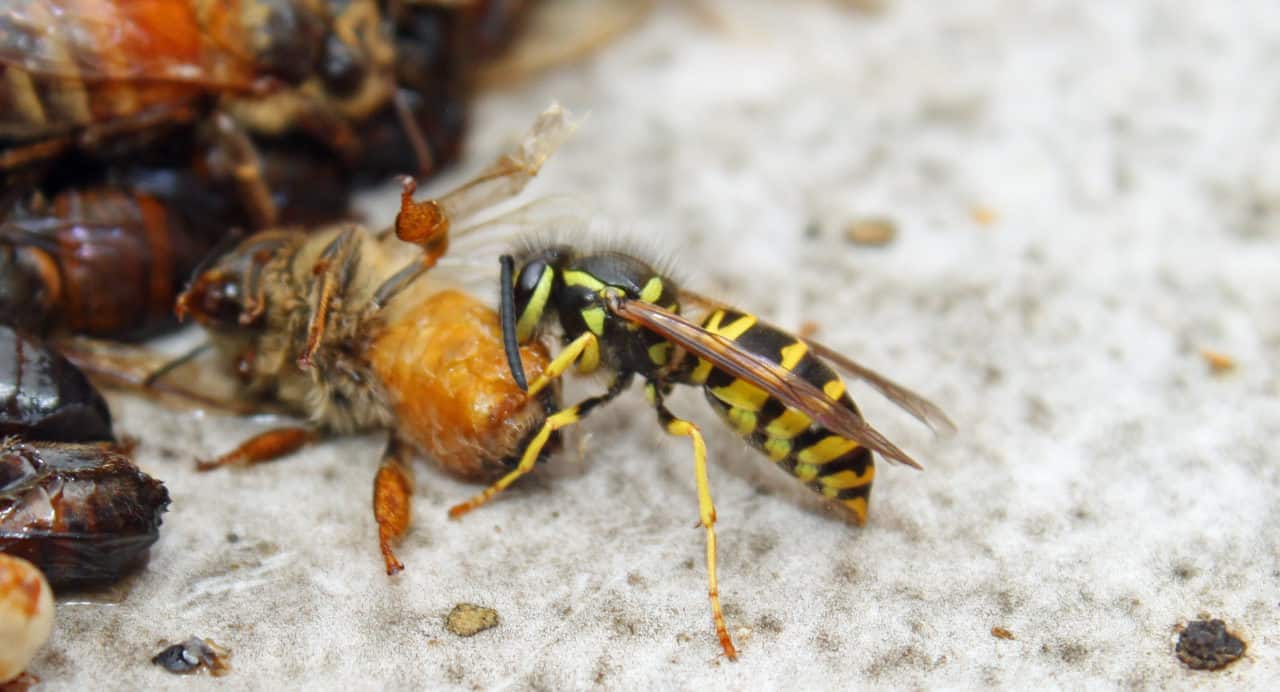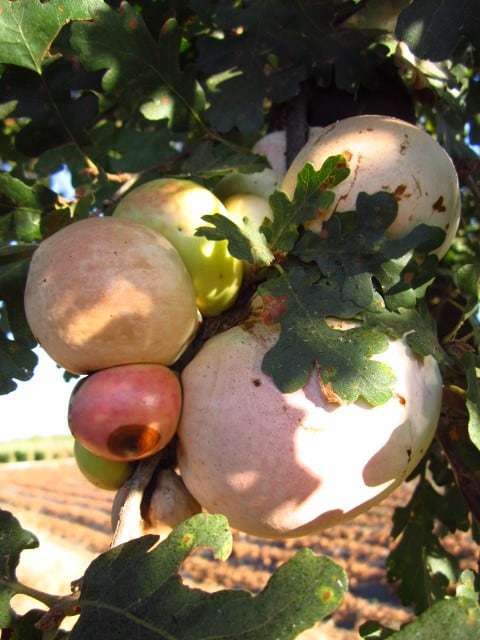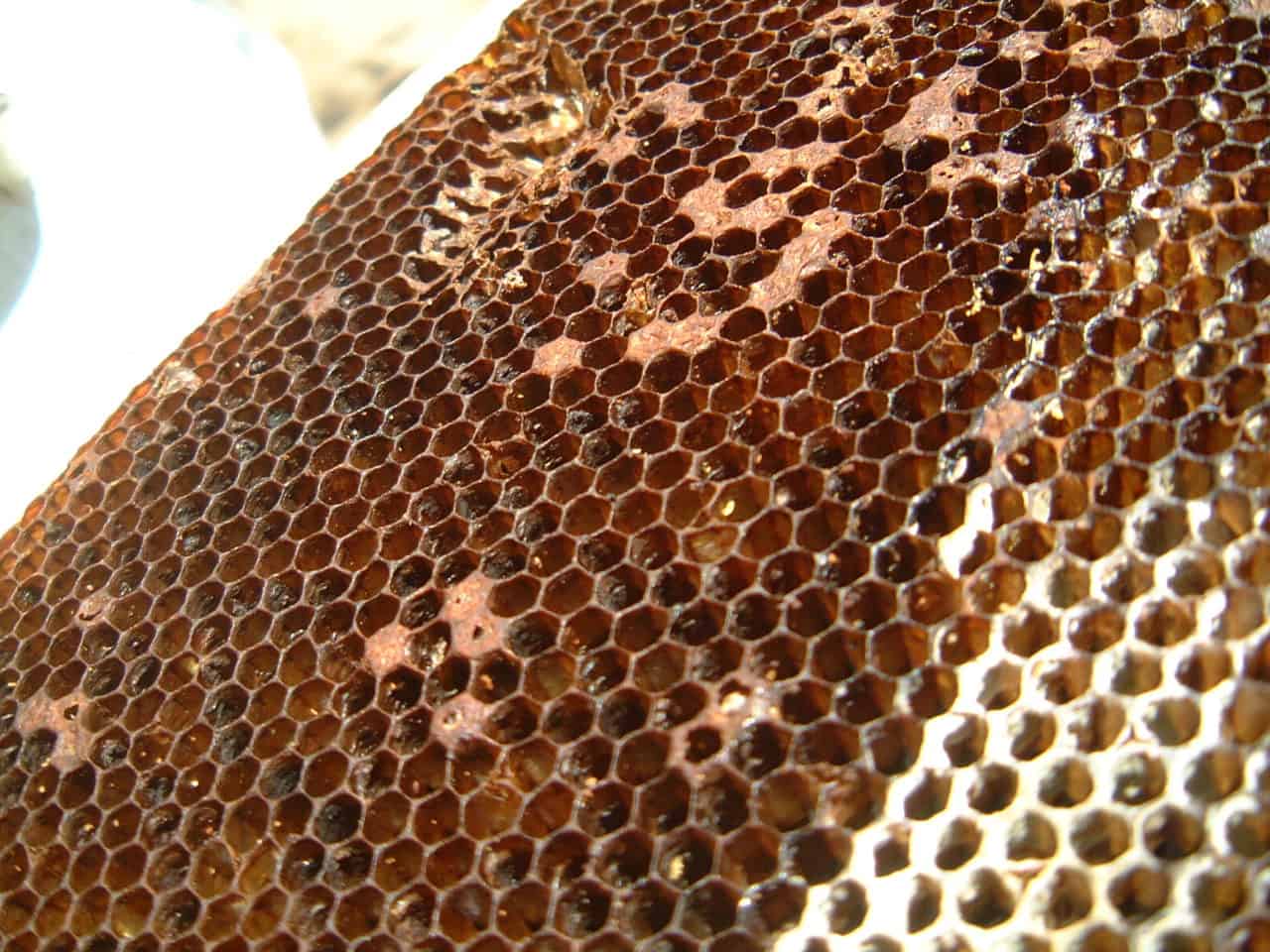Throughout the year several honey bee diseases can be noted in stressed or sick colonies. There are also other stress factors that cause colony conditions to deteriorate and look very similar to sick or diseased colonies. One condition is neglected drone brood. It is caused by either a drone laying queen, laying workers, poorly mated queens, or failing queens. The size of the colony will determine how long it takes to dwindle down and show signs of neglected drone brood. Most of the photos are from a colony that had a poorly mated queen. The symptoms appeared 10 days after she started to lay. In…
Category: Pest and Disease Control
Bald Brood
An interesting brood symptom you may come across in a weak hive in the spring is Bald Brood. Bald brood is caused by the Lesser wax moth (Achroia gresella) or the Greater wax moth (Galleria mellonella.) You can see in the image below the linear pattern of uncapping that occurs due to the wax moths tunneling behavior. These symptoms can sometimes be confused as hygienic behavior; I have included an image showing some hygienic behavior of uncapping. One visible difference between hygienic behavior vs. bald brood is that there is no linear pattern of uncapping sealed brood with hygienic behavior. Colonies with bald brood often…
Unknown Brood Damage
Posted 4/17/2013 This blog was changed from the original post. The title has changed from Pesticide brood Kill to Unknown Brood Damage. This change was in response to the comments I have received both on this blog and by emails, I want to clarify a few of my comments. First, I regret the original title of the blog as correctly noted; I had no concrete evidence that it was a pesticide brood kill. No pesticide analysis was done on the pollen or bees because, as I mentioned in the comments section, this beekeeper knew what was being sprayed, when it was being sprayed and the…
European Foulbrood (EFB) Part 2.
The most problematic pest beekeepers encounter in the United States today is the varroa mite. The varroa mite (Varroa destructor) is an ectoparasite associated with spreading disease, pathogens and reducing the lifespan of male and female honey bees. The mites accomplish this by creating wounds in honey bees with piercing/sucking mouthparts, then feeding on the hemolymph within. Research suggests that these mites transfer single-stranded RNA virus between bees, along with infections of bacteria, including Melissococcus pluton (EFB). This type of bacterial infection of larvae or pupa is considered a secondary infection, since the mite initiated the process and the bacteria followed. EFB is normally transmitted…
How to make a Sugar Roll jar
A sugar roll test is a simple way to monitor your varroa mite loads without killing a lot of bees. It is easy and fast and only a few items are needed. To make a sugar roll jar you will need a few supplies. You can get these supplies at a home improvement store and the grocery store. • Wide mouth quart canning jar with a two piece lid. You can use other sized jars as long as there is a two piece lid. • Screening-#8 mesh (8 squares per square inch) is preferred but you can use other screening as long as it allows…
Purple Brood
Liz and I spent a week in Southern California taking samples for the National Honey Bee Disease Survey. We came across purple brood – something I had never seen before. The larvae had a bright purple hue to them along their gut line. It was quite pretty. After some research, it seems that the most likely cause for purple brood is nectar from the plant Cyrilla racemiflora (common names are southern leatherwood or summer titi). It is poisonous to the brood, so beekeepers either have to move their colonies away or take the loss. Only one colony of the eight we sampled had it, so…
Whats wrong with my hive?
To determine if something is wrong with your hive, you must first know what a healthy, productive hive looks like. Knowing what a healthy colony looks like takes time, patience, and many hours in the hive to get a feel of what is going on in the colony throughout the year. Sometime the colony does not look so great and the size of the colony starts to dwindle. You can do two things here, panic or take a look at what is actually going on. Look at the brood, look at the bees(size, wings, uniformity, behavior), look at the sealed brood, look at the food…
Yellow Jackets
With winter approaching and food sources dwindling honey bee colonies are starting to be harassed by pests. Yellow Jackets are one of the most common pests, they feed on bees, larva, brood, honey bee bread and pretty much anything they can take advantage of in the hive. During this time of year when robbing becomes a problem, the yellow jackets will follow. During the chaos there is an open opportunity for yellow jackets to move in and take advantage of the situation. In Butte County, CA it was a very dry year so the yellow jackets will be a more serious problem with the lack…
Spotlight on Valley Oak
As we enter the final week of summer it seems fitting to talk about Quercus lobata Née, the Valley Oak. This tree is a late summer source of bee forage in Northern California where forage is scarce going into the fall. Valley oaks are endemic to California and are found in the interior valleys and foothills. At this time of year one can hear honey bees buzzing high up in the canopy. They’re not visiting flowers, but “oak apples,” a type of gall induced by the oak gall wasp Andricus quercuscalifornicus. What the bees are after is the honeydew the gall secretes. The tiny wasp…
Detecting American Foulbrood with a Blacklight: UPDATE
For clarification, using a blacklight is supposed to help you see if there are AFB scales in the bottom of a cell. The blacklight will make other things made of protien glow as well, so always double check that what you are seeing is a scale and not shaped like something else. An AFB scale should only be on the bottom of a cell (see picture). Be sure to look at the comb under a normal light as well, and if you are still not sure then ask or you can even send in a picture!


